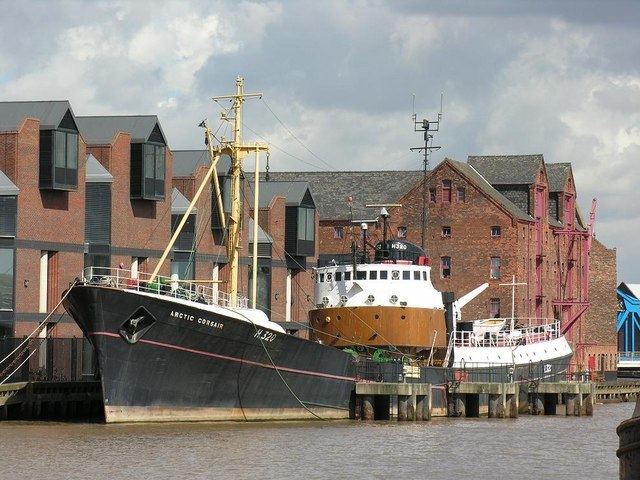Name Arctic Corsair Port of registry Hull Identification H320 Length 57 m Builder Cook, Welton & Gemmell | Owner Boyd Line Hull Yard number 959 Launched 29 February 1960 Phone +44 1482 613902 | |
 | ||
Renamed Arctic Cavalier (15 January 1988), back to Arctic Corsair (18 June 1993) Hours Closed today TuesdayClosedWednesday10AM–3PMThursdayClosedFridayClosedSaturday10AM–3PMSunday1:30–3PMMondayClosed Similar Streetlife Museum of Transport, Spurn Lightship, Southern Actor, Hull & East Riding Museum, Wilberforce House | ||
Arctic corsair virtual tour
The Arctic Corsair (H320) is a deep-sea trawler that was converted to a museum ship in 1999. It is berthed between Drypool Bridge and Myton Bridge in the River Hull in Hull, England, and is part of the city's Museums Quarter.
Contents
- Arctic corsair virtual tour
- Arctic corsair h320 being towed down the river hull and docked
- History
- Skippers
- References
Exhibits and guides aboard the boat tell the story of Hull's deep-sea fishing industry.
Arctic corsair h320 being towed down the river hull and docked
History
The Arctic Corsair is Hull’s last surviving sidewinder trawler, a type of ship that formed the backbone of the city’s deep sea fishing fleet. She was built in 1960, at Cook, Welton & Gemmell in Beverley, and was the second diesel-engined trawler built for the Boyd Line, the first being the Arctic Cavalier which was launched the previous month. She was designed for the harsh conditions encountered in the Icelandic grounds, having a rivetted rather than welded hull.
In September 1967 she was holed on her starboard side in a collision off the coast of Scotland with the Irish collier Olive in thick fog. Attempting to reach harbour in Wick she was beached in Sinclair Bay but eventually repaired and refloated.
In 1973, the Arctic Corsair broke the world record for landing of cod and haddock from the White Sea.
On 30 April 1976 during the cod wars, she rammed the offshore patrol vessel ICGV Odin in the stern, after Odin had made three attempts to cut the Corsair's trawl warps. The skipper, Charles Pitts, said that Icelandic seamen were becoming "more ambitious and dangerous in their tactics". With his ship holed below the waterline, and patched up temporarily by the Royal Navy, Pitts decided to head for home for permanent repairs. Arctic Corsair was out of action for several months.
In 1978 she was converted for midwater trawling, and in 1981 laid up at Hull. In 1985 she was taken out of retirement and reconverted for normal fishing. She was renamed Arctic Cavalier in 1988. She was sold to Hull City Council in 1993, renamed Arctic Corsair again, and moored in the River Hull for use as a museum ship.
After being restored by trainees and volunteers from the fishing heritage group STAND, the floating museum opened to the public in 1999. STAND entered into partnership with the City Council to provide volunteers to maintain and act as tour guides. Today, the floating museum is run entirely by volunteers but supported by Hull City Council. Vessel is open Wednesday, Saturday and Sundays (and Bank Holiday Mondays) from Easter until end of October. Guided tours are free.
Skippers
Many people worked on the ship during her long career. Her usual crew numbered 24. Skippers include:
